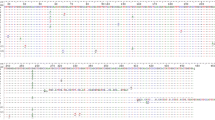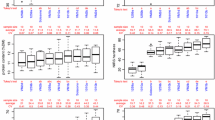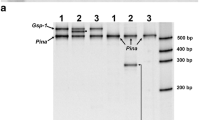Abstract
Wheat grain is sold based upon several physiochemical characteristics, one of the most important being grain texture. Grain texture in wheat directly affects many end use qualities such as milling yield, break flour yield, and starch damage. The hardness (Ha) locus located on the short arm of chromosome 5D is known to control grain hardness in wheat. This locus contains the puroindoline A (pina) and puroindoline B (pinb) genes. All wheats to date that have mutations in pina or pinb are hard textured, while wheats possessing both the ‘soft type’ pina-D1a and pinb-D1a sequences are soft. Furthermore, it has been shown that complementation of the pinb-D1b mutation in hard spring wheat can restore a soft phenotype. Here, our objective was to identify and characterize the effect the puroindoline genes have on grain texture independently and together. To accomplish this we transformed a hard red spring wheat possessing a pinb-D1b mutation with ‘soft type’ pina and pinb, creating transgenic isolines that have added pina, pinb, or pina and pinb. Northern blot analysis of developing control and transgenic lines indicated that grain hardness differences were correlated with the timing of the expression of the native and transgenically added puroindoline genes. The addition of PINA decreased grain hardness less than the reduction seen with added PINB. Seeds from lines having more ‘soft type’ PINB than PINA were the softest. Friabilin abundance was correlated with the presence of both ‘soft type’ PINA and PINB and did not correlate well with total puroindoline abundance. The data indicates that PINA and PINB interact to form friabilin and together affect wheat grain texture.






Similar content being viewed by others
References
American Association of Cereal Chemists (2000) Approved methods of the AACC, 10th edn. American Association of Cereal Chemistry, Minnesota
Baker RJ (1977) Inheritance of kernel hardness in spring wheat. Crop Sci 17:960–962
Barlow KK, Buttrose MM, Simmonds DH, Vesk M (1973) The nature of the starch-protein interface in wheat endosperm. Cereal Chem 50:443–454
Bechtel DB, Wilson JD, Martin CR (1996) Determining endosperm texture of developing hard and soft red winter wheats dried by different methods using the single-kernel wheat characterization system. Cereal Chem 73:567–570
Beecher B, Bettge A, Smidansky E, Giroux MJ (2002) Expression of wild-type pinB sequence in transgenic wheat complements a hard phenotype. Theor Appl Genet 105:870–877
Bettge AD, Morris CF, Greenblatt GA (1995) Assessing genotypic softness in single wheat kernels using starch granule-associated friabilin as a biochemical marker. Euphytica 86:65–72
Blechl AE, Anderson OD (1996) Expression of a novel high-molecular weight glutenin subunit gene in transgenic wheat. Nat Biotechnol 14:875–879
Blochet JE, Chevalier C, Forest E, Pebay-Peyroula E, Gautier MF, Joudrier P, Pezolet M, Marion D (1993) Complete amino acid sequence of puroindoline, a new basic and cysteine rich protein with a unique tryptophan-rich domain, isolated from wheat endosperm by Triton X-114 phase partitioning. FEBS Lett 329:336–340
Campbell KG, Bergman CJ, Gaulberto DG, Anderson JA, Giroux MJ, Hareland G, Fulcher RG, Sorrells ME, Finney PL (1999) Quantitative trait loci associated with kernel traits in a soft×hard wheat cross. Crop Sci 39:1184–1195
Dubreil L, Meliande S, Chiron H, Compoint JP, Quillien L, Branlard G, Marion D (1998) Effect of puroindolines on the breadmaking properties of wheat flour. Cereal Chem 75:222–229
Gautier MF, Aleman ME, Guirao A, Marioen D, Joudier P (1994) Triticum aestivum puroindolines, two basic cysteine-rich seed proteins: cDNA analysis and developmental gene expression. Plant Mol Biol 25:43–57
Gautier MF, Cosson P, Guirao A, Alary R, Joudrier P (2000) Puroindoline genes are highly conserved in diploid ancestor wheat and related species but absent in tetraploid Triticum species. Plant Sci 153:81–91
Giroux MJ, Morris CF (1997) A glycine to serine change in puroindoline b is associated with wheat grain hardness and low levels of starch-surface friabilin. Theor Appl Genet 95:857–864
Giroux MJ, Morris CF (1998) Wheat grain hardness results from highly conserved mutations in the friabilin components, puroindoline a and b. Proc Natl Acad Sci USA 95:6262–6266
Giroux MJ, Talbert L, Habernicht DK, Lanning S, Hemphill A, Martin JM (2000) Association of puroindoline sequence type and grain hardness in hard red spring wheat. Crop Sci 40:370–374
Giroux MJ, Sripo T, Gerhardt S, Sherwood JE (2003) Puroindolines: their role in grain hardness and plant defense. Biotechnol Genet Eng Rev (in press)
Greenwell P, Schofield JD (1986) A starch granule protein associated with endosperm softness in wheat. Cereal Chem 63:379–380
Jolly CJ, Rahman S, Korrt AA, Higgins TJV (1993) Characterization of the wheat Mr 15,000 ‘grain softness protein’ and analysis of the relationship between its accumulation in the whole seed and grain softness. Theor Appl Genet 86:589–597
Jolly CJ, Glenn GM, Rahman S (1996) GSP-1 genes are linked to the grain hardness locus (Ha) on wheat chromosome 5D. Proc Natl Acad Sci USA 93:2408–2413
Krishnamurthy K, Giroux MJ (2001) Expression of wheat puroindolines genes in transgenic rice enhances grain softness. Nature 19:162–166
Krishnamurthy K, Balconi C, Sherwood JE, Giroux MJ (2001) Increased tolerance to fungal diseases of rice plants transformed with puroindoline genes. Molec Plant Microbe Interact 13:1255–1260
Lanning SP, Talbert LE, McNeal FH, Alexander WL, McGuire CF, Bowman H, Carlson G, Jackson G, Eckhoff J, Kushnak G, Stewart V, Stallknecht G (1992) Registration of Hi-line wheat. Crop Sci 32:283–284
Law CN, Young CF, Brown JWS, Snape JW, Worland JW (1978) The study of grain protein control in wheat using whole chromosome substitution lines. In: Seed protein improvement by nuclear techniques. International Atomic Agency, Vienna, pp 483–502
Lillemo M, Morris CF (2000) A leucine to proline mutation in puroindoline b is frequently present in hard wheats from Northern Europe. Theor Appl Genet 100:1100–1107
Marion D, Gautier MF, Joudrier P, Ptak M, Pezolet M, Forest E, Clark DC, Broekaert W (1994) Structure and function of wheat lipid binding proteins. In: Wheat kernel proteins - molecular and functional aspects. Universita Degli Studi Della Tuscia, S Martino al Cimino, Italy, 28–30 September 1994, pp 175–180
Martin JM, Frohberg RC, Morris CF, Talbert LE, Giroux MJ (2001) Milling and bread baking traits associated with puroindoline sequence type in hard red spring wheat. Crop Sci 41:228–234
Mattern J, Morris R, Schmidt JW, Johnson VA (1973) Location of genes for kernel properties in the wheat cultivar ‘Cheyenne’ using chromosome substitution lines. In: Proceedings of the 4th International Wheat Genetics Symposium, University of Missouri, Columbia, 1973, pp 703–707
Morris CF, Rose SP (1996) Wheat. In: Cereal grain quality. Chapman and Hall, New York, pp 3–54
Morris CF, Greenblatt GA, Bettge AD, Malkawi HI (1994) Isolation and characterization of multiple forms of friabilin. J Cereal Sci 21:167–174
Morris CF, Lillemo M, Simeon GM, Giroux MJ, Babb S, Kidwell K (2001) Prevalence of puroindoline grain hardness genotypes among historically significant North American spring and winter wheats. Crop Sci 41:218–228
Riede CR, Anderson JA (1996) Linkage of RFLP markers to an aluminum tolerance gene in wheat. Crop Sci 36:905–909
Sivamani E, Brey CW, Dyer WE, Talbert LE, Qu R (2000) Resistance to wheat streak mosaic virus in transgenic wheat expressing the viral replicase (NIb) gene. Mol Breed 6:469–477
Sourdille P, Perretant MR, Charmet G, Leroy P, Gautier MF, Joudrier P, Nelson JC, Sorrells ME, Bernard M (1996) Linkage between RFLP markers and genes affecting kernel hardness in wheat. Theor Appl Genet 93:580–586
Sulaiman BD, Morrison RW (1990) Proteins associated with the surface of wheat starch granules purified by centrifuging through caesium chloride. J Cereal Sci 12:53–61
Symes KJ (1965) The inheritance of grain hardness in wheat as measured by particle size index. Aust J Agric Res 16:113–123
Symes KJ (1969) Influence of a gene causing hardness on the milling and baking quality of two wheats. Aust J Agric Res 20:971–979
Tranquilli G, Lijavetzky D, Muzzi G, Dubcovsky J (1999) Genetic and physical characterization of grain texture-related loci in diploid wheat. Mol Gen Genet 262:846–850
Turnbull KM, Turner M, Mukai Y, Yamamoto M, Morell MK, Appels R, Rahman S (2003) The organization of genes tightly linked to the Ha locus in Aegilops tauschii, the D-genome donor to wheat. Genome 46:330–338
Author information
Authors and Affiliations
Corresponding author
Additional information
Communicated by J. Dvorak
Rights and permissions
About this article
Cite this article
Hogg, A.C., Sripo, T., Beecher, B. et al. Wheat puroindolines interact to form friabilin and control wheat grain hardness. Theor Appl Genet 108, 1089–1097 (2004). https://doi.org/10.1007/s00122-003-1518-3
Received:
Accepted:
Published:
Issue Date:
DOI: https://doi.org/10.1007/s00122-003-1518-3




